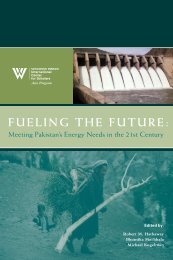Environmental Change and Security Project Report - Woodrow ...
Environmental Change and Security Project Report - Woodrow ...
Environmental Change and Security Project Report - Woodrow ...
You also want an ePaper? Increase the reach of your titles
YUMPU automatically turns print PDFs into web optimized ePapers that Google loves.
46<br />
be completely deforested in less than 20 years<br />
unless drastic measures are taken to reverse the<br />
trend (Teketay, Fetene, & Abate, 2003, page 11).<br />
Why such a high rate? Inhabitants are totally<br />
dependent on forest wood for construction <strong>and</strong><br />
fuel, <strong>and</strong> overcultivate <strong>and</strong> overgraze the l<strong>and</strong>.<br />
Deforestation is most pronounced in the highl<strong>and</strong>s<br />
due to the highly concentrated population,<br />
but even in the more favorable lowl<strong>and</strong>s, clearing<br />
forests <strong>and</strong> pastures for new migrants, coupled<br />
with archaic farming techniques, is rapidly<br />
destroying the ecosystem.<br />
Internal Migration<br />
To cope with the problems of l<strong>and</strong> degradation,<br />
the government has initiated a program to resettle<br />
people from the agriculturally poor highl<strong>and</strong>s<br />
to more fertile lowl<strong>and</strong>s. 6 While it is too early to<br />
judge the current program, it is hoped that the<br />
government will not repeat past mistakes.<br />
Previous resettlement programs were not voluntary.<br />
Neither were they based on serious economic,<br />
social, <strong>and</strong> environmental studies.<br />
According to social scientist Dessalegn Rahmato<br />
(2003), in response to the famines of the mid-<br />
1980s, the government resettled 600,000 people<br />
from the northern highl<strong>and</strong>s to the lowl<strong>and</strong>s of<br />
western Ethiopia, with terrible results:<br />
In this same period, some 33,000 settlers<br />
lost their lives due to disease, hunger, <strong>and</strong><br />
exhaustion <strong>and</strong> thous<strong>and</strong>s of families were<br />
broken up….The program involved considerable<br />
environmental damage. Large<br />
areas were cleared of their vegetation to<br />
build homesteads, to acquire farml<strong>and</strong><br />
<strong>and</strong> to construct access roads.<br />
Resettlement in particular failed to recognize<br />
the rights of local people or the carrying<br />
capacity of the areas of settlement.<br />
It created conflict between the host population<br />
<strong>and</strong> settlers. It also failed to adapt<br />
farming practices to the agro-ecological<br />
conditions of the lowl<strong>and</strong>s, <strong>and</strong> as a consequence,<br />
the environmental damage<br />
involved was quite considerable.<br />
Moreover, one of the objectives of resettlement<br />
was to reduce the population<br />
pressure of the highl<strong>and</strong>s <strong>and</strong> thereby to<br />
control natural resource degradation. In<br />
the end, resettlement had no or limited<br />
impact on population pressure or l<strong>and</strong><br />
degradation. (pages 13-14).<br />
The current resettlement effort may solve<br />
the immediate problem of drought <strong>and</strong> famine.<br />
In the long run, however, it will only distribute<br />
the problem geographically. While the government<br />
is trying to resettle about two million<br />
highl<strong>and</strong>ers in the next three years, the region’s<br />
population will increase by approximately five<br />
million people over the same period due to natural<br />
population growth. Also, as the population<br />
of the more fertile lowl<strong>and</strong>s of the south <strong>and</strong><br />
southwest grows, it will not be long before these<br />
areas also suffer a shortage of arable l<strong>and</strong> <strong>and</strong><br />
increased social tensions.<br />
Urbanization<br />
Urbanization is not yet a major problem in<br />
Ethiopia. However, the rate of population<br />
growth in urban areas is much higher than in<br />
rural areas: while the national population growth<br />
rate is 2.46 percent, the urban centers grow at a<br />
rate of 4.1 percent as drought <strong>and</strong> famine in the<br />
rural areas force people to seek alternative livelihoods<br />
in the cities (UNPD, 2003). As often is<br />
the case, urban expansion occurs at the expense<br />
of productive agricultural l<strong>and</strong>, which increases<br />
the pressure on available agricultural l<strong>and</strong>. The<br />
cities of Debre Zeit <strong>and</strong> Nazret (45 <strong>and</strong> 100 kilometers<br />
southeast of Addis Ababa) illustrate the<br />
desolation created by urban expansion: on each<br />
side of the main highway, rows of ugly <strong>and</strong> disorganized<br />
buildings are rising up to replace hectare<br />
after hectare of fertile agricultural l<strong>and</strong>. If the<br />
current pace of industrialization continues, the<br />
environmental damage <strong>and</strong> impact on agricultural<br />
production will be severe.<br />
The Way Forward<br />
Ethiopia’s developmental <strong>and</strong> environmental<br />
challenges are multifaceted <strong>and</strong> require multi-<br />
ECSP REPORT • ISSUE 10 • 2004

















